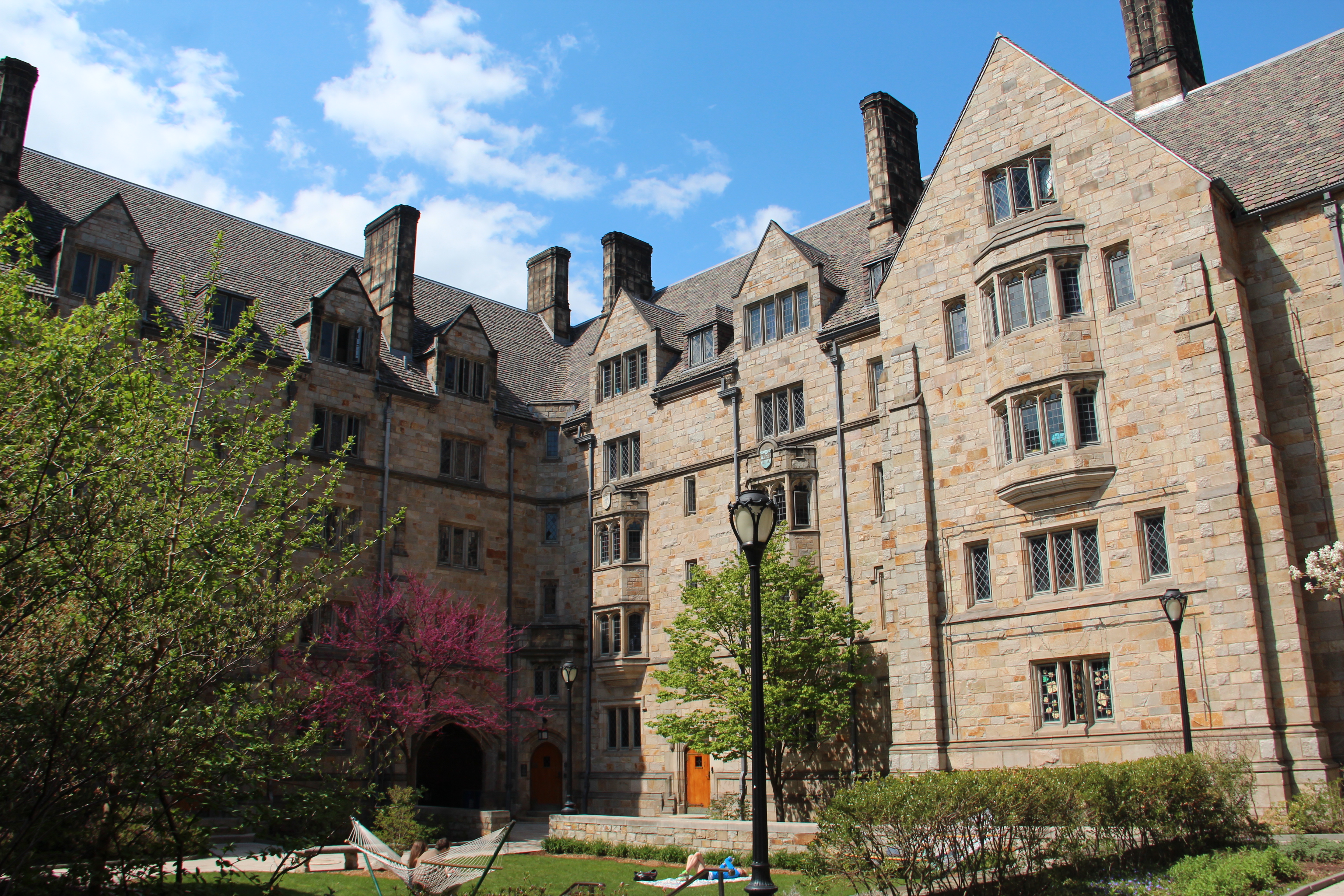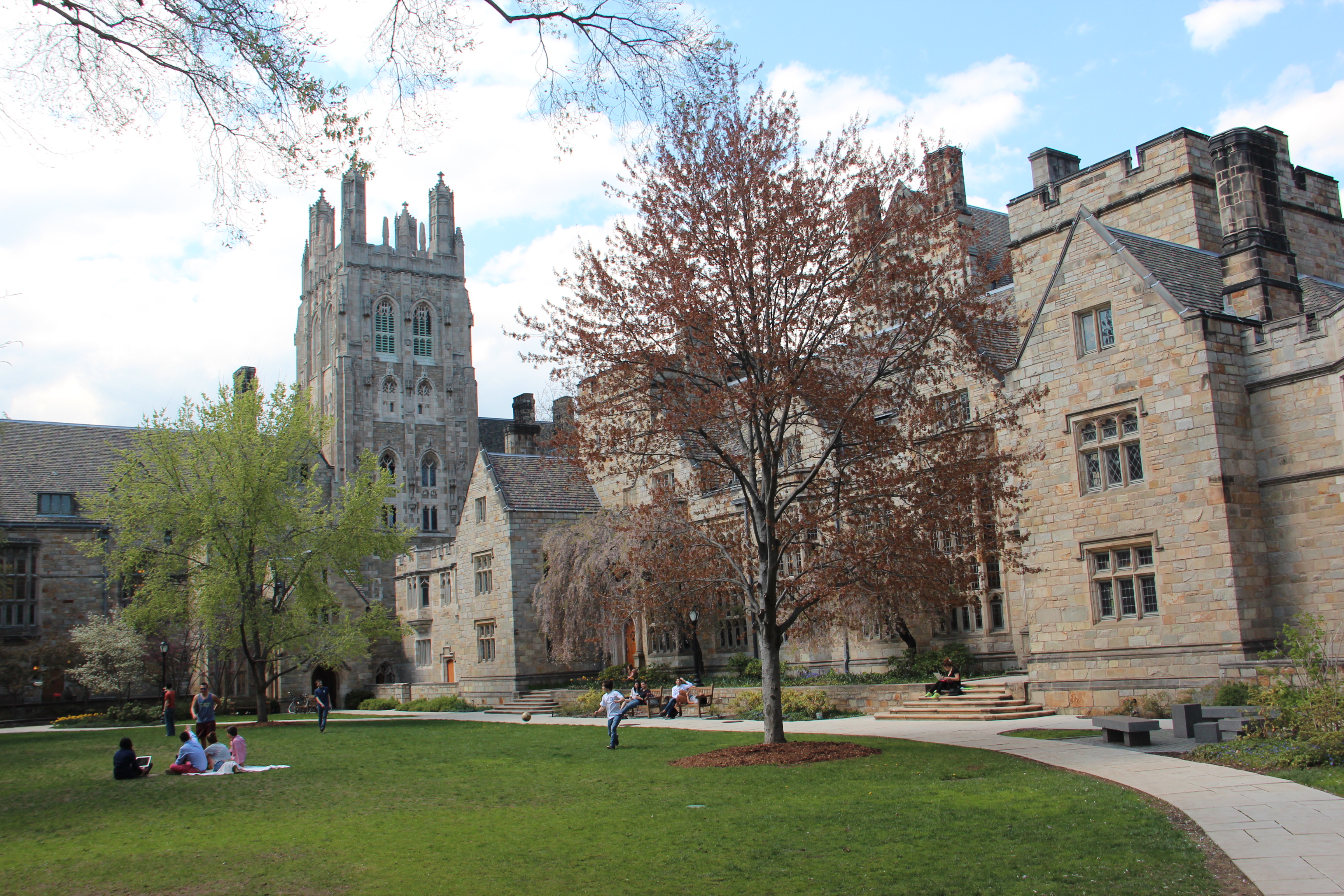Memorial Quadrangle on:
[Wikipedia]
[Google]
[Amazon]
 The Memorial Quadrangle is a residential quadrangle at
The Memorial Quadrangle is a residential quadrangle at
 Construction began in 1917, the bicentennial of Yale's first building in New Haven, and was completed in 1921. As initially built, the Quadrangle contained dorm rooms for 630 students, a dining hall, and seven courtyards. Dry
Construction began in 1917, the bicentennial of Yale's first building in New Haven, and was completed in 1921. As initially built, the Quadrangle contained dorm rooms for 630 students, a dining hall, and seven courtyards. Dry
 From 1921 to 1929 the building housed Yale College seniors. In 1928, a donation from Edward Harkness began Yale's residential college system, the buildings of which were also planned and designed by Rogers. Rogers split the Quadrangle into two residential colleges—Saybrook and Branford, so named for the courtyards they contain—and added mid-sized elements such as masters' houses, fellow's quarters, and dining halls. During the conversion, the "Gold Coast" of student rooms in the middle of the Quadrangle was hollowed out to make way for the Saybrook College dining hall. The colleges opened on September 25, 1933.
From 1921 to 1929 the building housed Yale College seniors. In 1928, a donation from Edward Harkness began Yale's residential college system, the buildings of which were also planned and designed by Rogers. Rogers split the Quadrangle into two residential colleges—Saybrook and Branford, so named for the courtyards they contain—and added mid-sized elements such as masters' houses, fellow's quarters, and dining halls. During the conversion, the "Gold Coast" of student rooms in the middle of the Quadrangle was hollowed out to make way for the Saybrook College dining hall. The colleges opened on September 25, 1933.
 The Memorial Quadrangle is a residential quadrangle at
The Memorial Quadrangle is a residential quadrangle at Yale University
Yale University is a Private university, private Ivy League research university in New Haven, Connecticut, United States. Founded in 1701, Yale is the List of Colonial Colleges, third-oldest institution of higher education in the United Stat ...
in New Haven, Connecticut
New Haven is a city of the U.S. state of Connecticut. It is located on New Haven Harbor on the northern shore of Long Island Sound. With a population of 135,081 as determined by the 2020 United States census, 2020 U.S. census, New Haven is List ...
. Commissioned in 1917 to supply much-needed student housing for Yale College
Yale College is the undergraduate college of Yale University. Founded in 1701, it is the original school of the university. Although other Yale schools were founded as early as 1810, all of Yale was officially known as Yale College until 1887, ...
, it was Yale's first Collegiate Gothic
Collegiate Gothic is an architectural style subgenre of Gothic Revival architecture, popular in the late-19th and early-20th centuries for college and high school buildings in the United States and Canada, and to a certain extent Europ ...
building and its first project by James Gamble Rogers
James Gamble Rogers (March 3, 1867 – October 1, 1947) was an American architect. A proponent of what came to be known as Collegiate Gothic architecture, he is best known for his academic commissions at Yale University, Columbia Univer ...
, who later designed ten other major buildings for the university. The Quadrangle has been occupied by Saybrook College and Branford College, two of the original ten residential colleges at Yale. The collegiate system of Yale University
Yale University is a Private university, private Ivy League research university in New Haven, Connecticut, United States. Founded in 1701, Yale is the List of Colonial Colleges, third-oldest institution of higher education in the United Stat ...
was largely inspired by the Oxbridge
Oxbridge is a portmanteau of the University of Oxford, Universities of Oxford and University of Cambridge, Cambridge, the two oldest, wealthiest, and most prestigious universities in the United Kingdom. The term is used to refer to them collect ...
model of residential and teaching colleges at the University of Oxford
The University of Oxford is a collegiate university, collegiate research university in Oxford, England. There is evidence of teaching as early as 1096, making it the oldest university in the English-speaking world and the List of oldest un ...
and the University of Cambridge
The University of Cambridge is a Public university, public collegiate university, collegiate research university in Cambridge, England. Founded in 1209, the University of Cambridge is the List of oldest universities in continuous operation, wo ...
in the UK.
The building was donated by Anna M. Harkness to memorialize her son, Yale College graduate Charles W. Harkness, who died in 1916. Charles' brother, Edward Harkness, became the primary benefactor of Yale's residential college system fifteen years later, a scheme which required a partial reconfiguration of the Memorial Quadrangle to create its two residential colleges. Harkness Tower
Harkness Tower is a masonry tower at Yale University in New Haven, Connecticut. Part of the Collegiate Gothic Memorial Quadrangle complex completed in 1922, it is named for Charles William Harkness, brother of Yale's largest benefactor, Edwa ...
, a large masonry tower on the building's west side, was named in memory of Charles Harkness, a memorial to whom is found in the tower's chapel.
Building
moat
A moat is a deep, broad ditch dug around a castle, fortification, building, or town, historically to provide it with a preliminary line of defence. Moats can be dry or filled with water. In some places, moats evolved into more extensive water d ...
s with low walls, a frequent architectural motif at Yale, were first used by this building and were planted with ivy
''Hedera'', commonly called ivy (plural ivies), is a genus of 12–15 species of evergreen climbing or ground-creeping woody plants in the family Araliaceae, native to Western Europe, Central Europe, Southern Europe, Macaronesia, northwestern ...
, flowers, and trees by landscape architect Beatrix Jones Farrand with an eye to both increased privacy and street beautification.
Harkness Tower
Harkness Tower is a masonry tower at Yale University in New Haven, Connecticut. Part of the Collegiate Gothic Memorial Quadrangle complex completed in 1922, it is named for Charles William Harkness, brother of Yale's largest benefactor, Edwa ...
, the most visible symbol of Yale on the New Haven
New Haven is a city of the U.S. state of Connecticut. It is located on New Haven Harbor on the northern shore of Long Island Sound. With a population of 135,081 as determined by the 2020 U.S. census, New Haven is the third largest city in Co ...
skyscape, is placed on an axis unifying it with Yale's Old Campus
The Old Campus is the oldest area of the Yale University campus in New Haven, Connecticut. It is the principal residence of Yale College freshmen and also contains offices for the academic departments of Classics, English, History, Comparative L ...
. The shorter Wrexham Tower is modeled on the tower of St Giles' Church in Wrexham
Wrexham ( ; ) is a city status in the United Kingdom, city in the North East Wales, north-east of Wales. It lies between the Cambrian Mountains, Welsh mountains and the lower River Dee, Wales, Dee Valley, near the England–Wales border, borde ...
, Wales
Wales ( ) is a Countries of the United Kingdom, country that is part of the United Kingdom. It is bordered by the Irish Sea to the north and west, England to the England–Wales border, east, the Bristol Channel to the south, and the Celtic ...
, where Elihu Yale
Elihu Yale (5 April 1649 – 8 July 1721) was a British Americans, British-American Colonialism, colonial administrator.
Born in Boston, Massachusetts, Yale lived in America only as a child, and spent the rest of his life in England, Wales, a ...
is buried.
The building is divided into seven courtyards, which Rogers framed with materials and decorative elements giving each distinct character. Three—Killingworth Court, Saybrook Court, and the largest, Branford Court—commemorate Connecticut towns significant to the school's founding, and a fourth, Wrexham Court, commemorating the city of Wrexham
Wrexham ( ; ) is a city status in the United Kingdom, city in the North East Wales, north-east of Wales. It lies between the Cambrian Mountains, Welsh mountains and the lower River Dee, Wales, Dee Valley, near the England–Wales border, borde ...
in Wales
Wales ( ) is a Countries of the United Kingdom, country that is part of the United Kingdom. It is bordered by the Irish Sea to the north and west, England to the England–Wales border, east, the Bristol Channel to the south, and the Celtic ...
, the resting place of Elihu Yale
Elihu Yale (5 April 1649 – 8 July 1721) was a British Americans, British-American Colonialism, colonial administrator.
Born in Boston, Massachusetts, Yale lived in America only as a child, and spent the rest of his life in England, Wales, a ...
. The other three, on the building's southern side and now part of Branford College, are named for early debating societies in Yale College: Brothers in Unity
Brothers in Unity (formally, the Society of Brothers in Unity) is an undergraduate literary and debating society at Yale University. Founded in 1768 as a literary and debating society that encompassed nearly half the student body at its 19th-centu ...
Court, Linonia Court, and Calliope Court after the Calliopean Society. Walls around these southward courtyards are several stories shorter than those on the north, allowing light to fill all of the quadrangle's open spaces more evenly.
The building's masonry exterior is richly ornamented, and much of the decoration commemorates distinguished university graduates. The gate beneath Harkness Tower, crafted by Samuel Yellin, is the most ornate of his many works at Yale. G. Owen Bonawit designed unique stained glass windowpanes for each student room. The roof of the building has been tiled with a custom Ludowici clay shingle since its construction.
Residential college integration
Influence
The Memorial Quadrangle became the template for Yale's residential college system. First announced as a "Quadrangle Plan," the colleges were built around the same courtyard and dining hall design pioneered. In addition to the two colleges that were created within the Memorial Quadrangle, six others—Jonathan Edwards, Davenport, Calhoun, Trumbull, and Berkeley—followed the same Collegiate Gothic style. Because of his initial work on the Memorial Quadrangle, Rogers became the de facto architect of Yale's central campus through the 1920s and 1930s: eight of the ten early residential colleges were his design, as wereSterling Memorial Library
Sterling Memorial Library (SML) is the main library, library building of the Yale University Library system in New Haven, Connecticut, United States. Opened in 1931, the library was designed by James Gamble Rogers as the centerpiece of Yale's Go ...
, Sterling Law Building, and the Hall of Graduate Studies. Many of the artisans who worked on the Memorial Quadrangle with Rogers, including G. Owen Bonawit and blacksmith Samuel Yellin, were commissioned again for these later buildings.
The quadrangle was an antecedent of the Collegiate Gothic
Collegiate Gothic is an architectural style subgenre of Gothic Revival architecture, popular in the late-19th and early-20th centuries for college and high school buildings in the United States and Canada, and to a certain extent Europ ...
style used throughout the United States, and of large residential campuses of the 20th century, including Harvard College and Rice University. In particular, plans for creating a residential undergraduate campus at the University of Chicago made heavy reference to the Memorial Quadrangle.
References
Further reading
* {{Yale Buildings and structures completed in 1921 1921 establishments in Connecticut Yale University buildings Courtyards